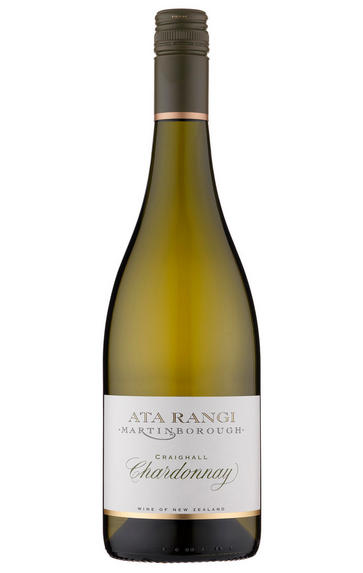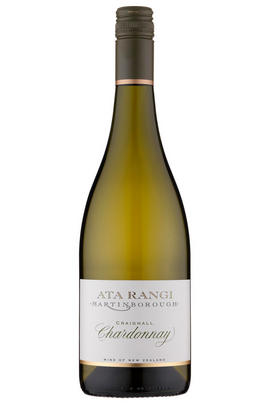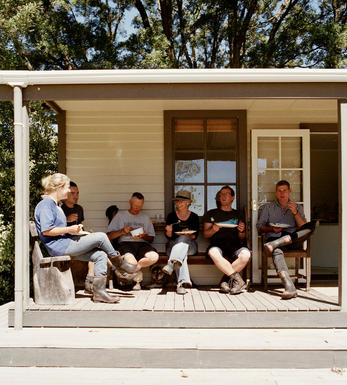
2013 Ata Rangi, Craighall Chardonnay, Martinborough, New Zealand

About this WINE

Ata Rangi
Ata Rangi is amongst the top ranks of New Zealand red wine producers. The name translates as "dawning sky" or "new beginning," and this is what it represented to Clive Paton, a dairy farmer who settled in Martinborough in 1980. Located at the southern end of the North Island, it is owned and managed by the family trio - Clive, his wife Phyll, and his sister Alison. The property consisted of a rather barren-looking 5-hectare paddock when he purchased it. He was attracted by the free-draining shingle terraces and the fact that Martinborough receives less rainfall than any other region in the North Island.
Clive planted his first vines on a small, stony sheep paddock at the edge of the Martinborough village in 1980 as one of a handful of people who pioneered wine growing in the area. 20 years later all of the wines are on strict allocation with demand far exceeding supply. The Pinot Noir is world-class and displays a structure and depth of fruit seldom encountered outside Burgundy. Célèbre is an intriguing blend of Cabernet Sauvignon, Merlot, and Syrah, which is a powerful and complex wine with very good ageing potential. A high-quality Chardonnay is also produced.
Ata Rangi Pinot Noir is undoubtedly the flagship wine, and in 2010 was honored with the inaugural Tipuranga Teitei o Aotearoa or "Grand Cru of New Zealand." With a skilled team in place, including dynamic winemaker Helen Masters, Ata Rangi continues to lead the field. Their Pinots often remain delicious even beyond 10 years old.

Martinborough
Close to the southern tip of North Island, some top-class, aromatic Pinot Noir is being made in the sleepy town of Martinborough, with the best rivalling good Burgundy. Compared to the hustle and bustle of Marlborough, the pocket-sized Wairarapa district – with Martinborough at its head – comes across less as a wine-producing region, accounting as it does for three-point-five percent of the country's vines, and more like a cottage industry. Much of this is perhaps down to the compact size of its favoured old-Martinborough terrace with its gravely, sandy, alluvial soils, located an hour's drive east of the country's capital, Wellington.
Another factor is the nature of the winegrowers themselves, often holding down a professional career during the week, and tending their vines at the weekends; so more therapy than husbandry, reflected perhaps in the relatively high land values, making commercial viticulture a tricky proposition. Added to which, and despite being in a rain shadow, this south-eastern corner of North Island is constantly at the mercy of the icy south-easterlies spinning off the Antarctic, bringing frosts five or six times a year, from flowering through to harvest. Pinot Noir yields are therefore often at the 25-30 hl/ha mark.
Just as Cloudy Bay launched a hundred wineries in Marlborough, so it could be argued that Dry River Wines and Ata Rangi provided the spark that lit up Martinborough. While the region's history dates back to the first commercial vintage of 1893, Prohibition intervened, followed by Marlborough's debut, hence Dry River's inaugural vintage was only in 1979, with Clive Paton releasing Ata Rangi in 1985.
Much of the initial buzz surrounding the region came from the Abel or `Gumboot' clone of Pinot Noir whose origins apparently lie in a certain Romanée-Conti vineyard. During the 1960s or 1970s, a cutting was allegedly smuggled into New Zealand via a gumboot, discovered by the then customs officer Malcolm Abel who in turn propagated it on the quiet before releasing it to Ata Rangi. To this day, one sniff of a barrel of Abel Pinot Noir conjures up visions of Musigny – something evidently not lost on Nigel Greening, who planted most of his Cornish Point vineyard with it.
Though Pinot Noir put the region on the map and continues to turn heads in the hands of Dr Neil McCallum (Dry River), Clive Paton (Ata Rangi), and, more recently, Chris Archer of Alana Estate, economically the region is arguably better-suited to Sauvignon Blanc, Riesling and even Gewürztraminer. Unlike Marlborough, or Burgundy for that matter, this region has to juggle several varieties to make ends meet – not an easy task. The regional style is dark plum and chocolate black fruit, with a savouriness akin to meat.

Chardonnay
Chardonnay is often seen as the king of white wine grapes and one of the most widely planted in the world It is suited to a wide variety of soils, though it excels in soils with a high limestone content as found in Champagne, Chablis, and the Côte D`Or.
Burgundy is Chardonnay's spiritual home and the best White Burgundies are dry, rich, honeyed wines with marvellous poise, elegance and balance. They are unquestionably the finest dry white wines in the world. Chardonnay plays a crucial role in the Champagne blend, providing structure and finesse, and is the sole grape in Blanc de Blancs.
It is quantitatively important in California and Australia, is widely planted in Chile and South Africa, and is the second most widely planted grape in New Zealand. In warm climates Chardonnay has a tendency to develop very high sugar levels during the final stages of ripening and this can occur at the expense of acidity. Late picking is a common problem and can result in blowsy and flabby wines that lack structure and definition.
Recently in the New World, we have seen a move towards more elegant, better- balanced and less oak-driven Chardonnays, and this is to be welcomed.


Buying options
Add to wishlist
Description
Attractively bright red fruit on the nose – Raspberry, red currant and plum fruit combined with notes of sous bois and vanillin spice. Elegant and svelte on the palate. Lovely persistent fruit that extends onto a lovely spicy length. Excellently balanced with nice hint of tannin material that grips and gives the wine a certain gravitas. A gentle caressing Pinot Noir but with serious intention. Lovely now but will gain great complexity over the next 5 – 8 years.
Stuart Rae, Fine Wine
wine at a glance
Delivery and quality guarantee